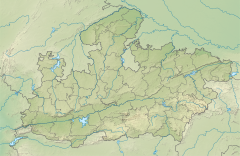| Mandasor Pillar inscription of Yasodharman | |
|---|---|
 Imprint of the Mandasor Yashodharman Inscription | |
| Material | Red sandstone pillar |
| Writing | Sanskrit |
| Created | 515–550 CE |
| Period/culture | Gupta Empire era |
| Discovered | 1884 |
| Place | Sondhani, Mandasor |
| Present location | Yashodharman Museum |
The Mandasor Pillar Inscriptions of Yashodharman are a set of Sanskrit inscriptions from early 6th-century discovered at an archaeological site at the village of Sondani (सोंधनी), about 4 kilometers south of Mandsaur (Mandasor) in northwestern Madhya Pradesh, India. These record the victory of Aulikara king Yasodharman over the Huna king Mihirakula. According to Richard Salomon, these are notable for "their outstanding literary, calligraphic and historical value".[1] The Mandasor inscription praises Yasodharman, describes him as having rescued the earth from "rude and cruel kings of the Kali age, who delight in viciousness".[2]
Fleet first published his translation of the inscription in 1888. Fleet's translation of the inscription has been corrected by various scholars.[3]
- ^ Richard Salomon (1998). Indian Epigraphy: A Guide to the Study of Inscriptions in Sanskrit, Prakrit, and the other Indo-Aryan Languages. Oxford University Press. p. 146. ISBN 978-0-19-535666-3.
- ^ Fleet, John F. Corpus Inscriptionum Indicarum: Inscriptions of the Early Guptas. Vol. III. Calcutta: Government of India, Central Publications Branch, 1888, 147-148.
 This article incorporates text from this source, which is in the public domain.
This article incorporates text from this source, which is in the public domain.
- ^ Agrawal, Jagannath (1986). "A study of some verses of the Mandasor Stone inscription dated Malava Year 529". Journal of the Royal Asiatic Society of Great Britain & Ireland. 118 (1). Cambridge University Press: 53–58. doi:10.1017/s0035869x00139103.

